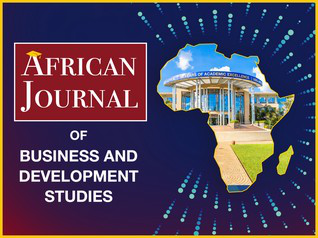Optimizing Team Outcomes through Structuring for Results
Evidence from Kenyan Courier Companies
DOI:
https://doi.org/10.70641/ajbds.v2i1.154Keywords:
Courier industry, Team Structures, Team Leadership, Monitoring and Feedback, Team performanceAbstract
This study investigated the influence of structuring team for results on team performance among courier companies in Kenya. This study draws on the Hill Model for team leadership, specifically focusing on the internal leadership actions that follow a leader’s top-down evaluation of their teams. The action of leaders in structuring for results comprises the elements of planning and visioning, creating a delivery oriented team, and monitoring and feedback. Guided by post-positivist philosophy and a descriptive research design, this study adopted a descriptive correlational design targeting 244 departmental team leaders from four key teams across 61 CAK-licensed international courier companies in Kenya. Through stratified random sampling, 166 leaders were selected, with 156 completing a self-administered electronic questionnaire, yielding a response rate of 94 %. Data were analyzed using IBM SPSS version 29, and the following statistical techniques were applied: descriptive statistics, frequency distributions, means and standard deviations, inferential statistics, correlation, chi-square tests, One-way ANOVA, and ordinal logistic regression. The results revealed that structuring for results significantly influenced team performance, as demonstrated by a Nagelkerke Pseudo R², which indicated that 48.7% of the variance was explained by structuring the results (R² = .487), and parameter estimates showed that it significantly predicted team performance (β =-1.135, p ≤.05). These findings align with prior research that indicated that structured mechanisms improved goal alignment, whereas monitoring and feedback enhanced team cohesion and performance. The study recommended leveraging the ongoing digital transformation to create platforms that enhance feedback and transparency that can lead to a robust and cohesive team. Future studies could apply the model to other sectors such as transportation, healthcare, and education to test whether the findings are similar across different operational contexts.
References
Abrahamsen, M. H., Halinen, A., & Naudé, P. (2023). The role of visioning in business network strategizing. Journal of Business Research, 154, 113334. https://doi.org/10.1016/j.jbusres.2022.113334 DOI: https://doi.org/10.1016/j.jbusres.2022.113334
Arora, N., & Chaudhary, S. (2023). Turning Conflict into Collaboration: The Power of Constructive Conflict Management for Your Team. Journal of Population Therapeutics and Clinical Pharmacology, 30(15), Article 006. https://doi.org/10.47750/jptcp.2023.30.15.006 DOI: https://doi.org/10.47750/jptcp.2023.30.15.006
Benishek, L. E., & Lazzara, E. H. (2019). Teams in a New Era: Some Considerations and Implications. Frontiers in Psychology, 10, 1006. https://doi.org/10.3389/fpsyg.2019.01006 DOI: https://doi.org/10.3389/fpsyg.2019.01006
Chiguvi, D., Zaranyika, T., Marozwa, M., & Dube, Z. (2023). The effect of visioning on digital transformation in the insurance industry. International Journal of Research in Business and Social Science, 12 (2), 23–29. https://doi.org/10.20525/ijrbs.v12i2.2346 DOI: https://doi.org/10.20525/ijrbs.v12i2.2346
Cininta, R. A. T., & Wisesa, A. (2023). The Impact of Role Ambiguity on Team Performance Inside a Startup. Scholars Bulletin, 9(07), 80–85. https://doi.org/10.36348/sb.2023.v09i07.001 DOI: https://doi.org/10.36348/sb.2023.v09i07.001
Communication Authority. (2022). Baseline Survey for Postal and Courier Services in Kenya [Survey].Nairobi, Kenya. Communication Authority of Kenya.
Downloads
Published
How to Cite
Issue
Section
License
Copyright (c) 2025 Gicho Dan, K’Aol George, Kiriri Peter

This work is licensed under a Creative Commons Attribution-NonCommercial-ShareAlike 4.0 International License.





 This work is licensed under a
This work is licensed under a 